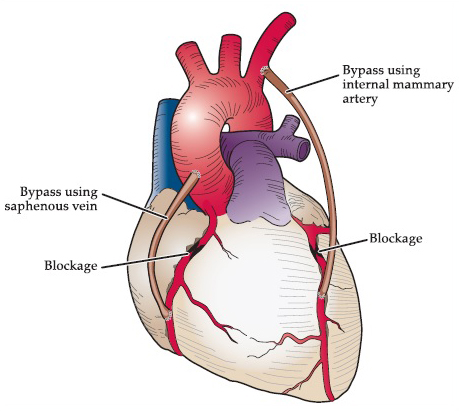Coronary artery disease (blocked arteries)
Coronary artery disease is one of the most frequent causes of death. The incidence of myocardial infarct (heart attack) every year is very high.
Coronary disease is the narrowing or blockage of the coronary arteries, usually caused by atherosclerosis. Atherosclerosis (sometimes called “hardening” or “clogging” of the arteries) is the build-up of fatty deposits (called plaques) on the inner walls of the arteries. It can cause a heart attack or symptoms like angina (chest pain), shortness of breath and tiredness, because it causes a reduced blood supply and eventually damage to the heart muscle. Several risk factors like smoking, diabetes, high cholesterol, high blood pressure, poor diet and sedentary life can produce narrowing of the heart arteries.
The most effective treatment for narrowed or blocked heart arteries is the surgical operation of Coronary Artery Bypass Graft. The aim of the operation is to restore the proper blood supply to the heart. It is made by harvesting conduits like other arteries and veins (left and right internal mammary artery from the chest, radial artery from the arm and long saphenous vein from the leg), which are then stitched onto the heart arteries beyond the blockage to improve the blood flow to the heart muscle.

This procedure normally is performed stopping the heart, ‘on-pump’ (using the cardiopulmonary bypass machine or ‘heart-lung machine’), but it can also be performed on a beating heart, ‘off-pump’, which gives great advantages, particularly to high risk patients, as it can reduce the risk of complications like stroke, kidney failure, lung failure, peripheral vascular disease. Mr Alberto Albanese routinely performs coronary artery bypass surgery with excellent results and also has a special interest and a very good experience in beating heart surgery, having had a long training in off-pump surgery.
Mr ALBERTO ALBANESE
Home
About Me
Services
Coronary Artery disease (blocked arteries)
Aortic valve disease
Mitral valve disease
Tricuspid valve disease
Aortic aneurysm
Atrial septal defects
Cardiac tumours
Arrhythmia (irregular heart rhythm)
International Heart Clinic
Locations – The Harley Street Clinic
Locations – Essex Cardiothoracic Centre
Locations – Italy
Contacts
- Privacy Policy and Cookies
- 2020 of Alberto Albanese
Mr ALBERTO ALBANESE
Home
About Me
Services
Coronary Artery disease (blocked)
Aortic valve disease
Mitral valve disease
Tricuspid valve disease
Aortic aneurysm
Atrial septal defects
Cardiac tumours
Arrhythmia (irregular heart rhythm)
International Heart Clinic
Locations – The Harley Street Clinic
Locations – Essex Cardiothoracic Centre
Locations – Italy
Contacts
Mr ALBERTO ALBANESE
Home
About Me
Services
Coronary Artery disease (blocked arteries)
Aortic valve disease
Mitral valve disease
Tricuspid valve disease
Aortic aneurysm
Atrial septal defects
Cardiac tumours
Arrhythmia (irregular heart rhythm)
International Heart Clinic
Locations – The Harley Street Clinic
Locations – Essex Cardiothoracic Centre
Locations – Italy
Contacts
- 2020 of Alberto Albanese
- Privacy Policy and Cookies

